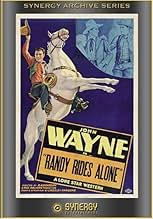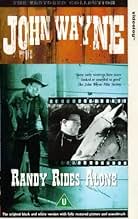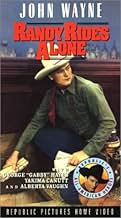IMDb-BEWERTUNG
5,3/10
1280
IHRE BEWERTUNG
Füge eine Handlung in deiner Sprache hinzuJailed for murders he didn't commit, Randy escapes only to stumble into the den of the real murderers.Jailed for murders he didn't commit, Randy escapes only to stumble into the den of the real murderers.Jailed for murders he didn't commit, Randy escapes only to stumble into the den of the real murderers.
George 'Gabby' Hayes
- Marvin Black aka Matt the Mute
- (as George Hayes)
Artie Ortego
- Deputy Al
- (as Arthur Artego)
Horace B. Carpenter
- Ed Rogers
- (Nicht genannt)
Tommy Coats
- Kidnapper Joe
- (Nicht genannt)
Herman Hack
- Posse Rider
- (Nicht genannt)
- …
Perry Murdock
- Kidnapper Slim
- (Nicht genannt)
Tex Palmer
- Henchman
- (Nicht genannt)
Mack V. Wright
- Deputy
- (Nicht genannt)
Empfohlene Bewertungen
Above average fare from the Lone Star crew of worthies-- Hayes, Canutt, Dwire, and of course Wayne. Lindsley Parsons did several scripts for Wayne and Lone Star, but this one's arguably his best. Wayne's an undercover agent on the trail of an outlaw gang whose latest robbery ends in a massacre of saloon patrons and staff. The opening is a grabber as the camera surveys the corpse strewn floor, while a player piano bangs away in the background, eyes peer from holes in a painting, and a secret panel opens. The outlaw gang has a neat hideout in a hollow behind a waterfall. Their digs even includes, of all things, its own jail where the leading lady ends up! Some good hard riding, including (alas!) a trip-wire spill that looks dramatic, but I wonder if the horse survived. Canutt comes up with usual spectacular stunt as Wayne takes a fall from a ladder high up a rock face. Can't help but notice that Alberta Vaughn looks much too young to stack up as an adult leading lady, but manages okay in the acting department. The movie's unusual for rare use of a miniature as a special effect. It's pretty well done and money well spent since the ending makes unexpectedly good use of it. All in all, it's good clean fun, as they used to say.
RANDY RIDES ALONE (Monogram Pictures, 1934), directed by Harry Fraser, stars John Wayne in his seventh "Lone Star" western presentation. With story/screenplay by Lindsley Parsons, production values still on a low-budget scale, but plot summary is tightly edited with everything told under an hour. Overall, it's still an interesting little item with a mixture of western and mystery.
The story introduces Randy Barlow (John Wayne), a lone cowboy riding through town to meet with Ed Rogers. Coming to the saloon called the Half-Way House which Rogers owns, Randy enters to the sound of piano playing music only to be surrounded by a massacre of dead bodies, one of them being Rogers. Unknown to him is a picture on the wall with moving eyes watching his every move. Moments later, the sheriff (Earl Dwire) and his deputies enter with Matt the Mute (George Hayes), who had earlier notified the sheriff of the gunshots. He insists the cowboy be arrested as a possible suspect connected with a gang of killers. While in jail, Randy is met with Sally Rogers (Alberta Vaughn), the niece of the deceased, whom she believes is not the guilty man. Sally arranges for Randy's escape and for him to meet with her at sunup. Sally is informed through a letter of introduction by the Adams Express Company in Denver, Colorado, that Randy is a government agent sent by Ed to investigate Marvin Black, a man pressuring him to sell him the saloon. After Randy is pursued on horseback by a posse, his escape leads him to the cave hideout of Marvin Black where he finds sally being held hostage. Supporting players include Yakima Canutt (Spike); Tex Phelps and Perry Murdock.
What makes RANDY RIDES ALONE watchable is the prescense of the unrecognizable George "Gabby" Hayes years before his bearded sidekick roles in a straight role playing a mute speaking through his written messages. Though never addressed verbally as Randy, Wayne's character is only known through camera closeup to his letter of introduction, otherwise to others he's simply a nameless cowboy who rides alone. Alberta Vaughn, the heroine in the story who hides in secret panels, whose distrust is on everybody except for a the cowboy stranger in town. Some good stunts with interesting finish make this worthwhile viewing.
A long unseen western turned up regularly on public television starting in the early 1980s, leading for its rediscovery on video cassette and later the DVD process. Cable television broadcasts include American Movie Classics (1996-2000), Turner Classic Movies (TCM premiere: May 1996) and Encore Westerns. Although clocked at 53 minutes, some sources time RANDY RIDES ALONE at 57 minutes, though jump cuts don't seem visible in existing prints. Beware of RANDY RIDES ALONE often shown with inferior intrusive underscoring added during its long muted sequences. (**)
The story introduces Randy Barlow (John Wayne), a lone cowboy riding through town to meet with Ed Rogers. Coming to the saloon called the Half-Way House which Rogers owns, Randy enters to the sound of piano playing music only to be surrounded by a massacre of dead bodies, one of them being Rogers. Unknown to him is a picture on the wall with moving eyes watching his every move. Moments later, the sheriff (Earl Dwire) and his deputies enter with Matt the Mute (George Hayes), who had earlier notified the sheriff of the gunshots. He insists the cowboy be arrested as a possible suspect connected with a gang of killers. While in jail, Randy is met with Sally Rogers (Alberta Vaughn), the niece of the deceased, whom she believes is not the guilty man. Sally arranges for Randy's escape and for him to meet with her at sunup. Sally is informed through a letter of introduction by the Adams Express Company in Denver, Colorado, that Randy is a government agent sent by Ed to investigate Marvin Black, a man pressuring him to sell him the saloon. After Randy is pursued on horseback by a posse, his escape leads him to the cave hideout of Marvin Black where he finds sally being held hostage. Supporting players include Yakima Canutt (Spike); Tex Phelps and Perry Murdock.
What makes RANDY RIDES ALONE watchable is the prescense of the unrecognizable George "Gabby" Hayes years before his bearded sidekick roles in a straight role playing a mute speaking through his written messages. Though never addressed verbally as Randy, Wayne's character is only known through camera closeup to his letter of introduction, otherwise to others he's simply a nameless cowboy who rides alone. Alberta Vaughn, the heroine in the story who hides in secret panels, whose distrust is on everybody except for a the cowboy stranger in town. Some good stunts with interesting finish make this worthwhile viewing.
A long unseen western turned up regularly on public television starting in the early 1980s, leading for its rediscovery on video cassette and later the DVD process. Cable television broadcasts include American Movie Classics (1996-2000), Turner Classic Movies (TCM premiere: May 1996) and Encore Westerns. Although clocked at 53 minutes, some sources time RANDY RIDES ALONE at 57 minutes, though jump cuts don't seem visible in existing prints. Beware of RANDY RIDES ALONE often shown with inferior intrusive underscoring added during its long muted sequences. (**)
John Wayne rides into a saloon and finds the player piano running and everyone in the place dead. The safe has been broken into as well. As Wayne investigates the scene the sheriff and posse arrive and promptly arrest Wayne vowing to get his gang as well. Breaking out of the jail with the help of the saloon owner because she knows he didn't do it Wayne is off to find out who did.
Though held by many as a classic, I'm not too sure of its status. Its certainly got some good moments and at least one classic moment in it, but its not really a classic sort of film. The opening of the film where John Wayne walks into the saloon and finds everyone dead is one of the creepiest sequences I've ever seen in any sort of film. There is something unsettling about the whole affair that really gets under your skin. Its the type of thing that makes you sit up and pay attention, I just wish the rest of the film was on on par with that one scene.
Unfortunately this 53 minute film also has a great deal of filler. There are frequent stretches were people just ride between locations. This doesn't include the chases which seem to spring up every five minutes or so. Its deadly and it kills the pace of the film which would be a taut 30 or 35 minute with out them.
Worth a look for that one scene if nothing else.
Though held by many as a classic, I'm not too sure of its status. Its certainly got some good moments and at least one classic moment in it, but its not really a classic sort of film. The opening of the film where John Wayne walks into the saloon and finds everyone dead is one of the creepiest sequences I've ever seen in any sort of film. There is something unsettling about the whole affair that really gets under your skin. Its the type of thing that makes you sit up and pay attention, I just wish the rest of the film was on on par with that one scene.
Unfortunately this 53 minute film also has a great deal of filler. There are frequent stretches were people just ride between locations. This doesn't include the chases which seem to spring up every five minutes or so. Its deadly and it kills the pace of the film which would be a taut 30 or 35 minute with out them.
Worth a look for that one scene if nothing else.
"Randy Rides Alone" is one of the better entries in John Wayne's Lone Star westerns made in the early to mid 30s. And if you've ever wondered what George "Gabby" Hayes looked like without his whiskers, then this film is for you.
Wayne plays undercover investigator Randy Bowers who is sent to investigate a series of robberies committed by Marvin Black (Hayes) and his gang. He comes upon a half-way house which has apparently been robbed and everyone in it killed. But heroine Alberta Vaughn has escaped by hiding in a secret back room. Bowers meanwhile, is arrested for the carnage by the sheriff (Earl Dwire). Black masquerades as Marvin the Mute, the General Store owner, a respectable townsman. Bowers escapes jail and manages to infiltrate the gang and well, you probably can guess the rest.
John Wayne was in the midst of learning his craft in this series. This entry is better than most, particularly the "Singing Sandy" pictures. Hayes before he became "Gabby", played a variety of roles in the series. Sometimes he was the villain, other times the father of the heroine and sometimes a forerunner of the grizzled sidekick that we would soon come to know. Veteran stuntman Yakima Canutt also worked regularly in the series doubling just about everybody. He also played the parts of henchmen in several of them. In this one he's Hayes chief henchman "Spike".
Not a bad "B" western for its time.
Wayne plays undercover investigator Randy Bowers who is sent to investigate a series of robberies committed by Marvin Black (Hayes) and his gang. He comes upon a half-way house which has apparently been robbed and everyone in it killed. But heroine Alberta Vaughn has escaped by hiding in a secret back room. Bowers meanwhile, is arrested for the carnage by the sheriff (Earl Dwire). Black masquerades as Marvin the Mute, the General Store owner, a respectable townsman. Bowers escapes jail and manages to infiltrate the gang and well, you probably can guess the rest.
John Wayne was in the midst of learning his craft in this series. This entry is better than most, particularly the "Singing Sandy" pictures. Hayes before he became "Gabby", played a variety of roles in the series. Sometimes he was the villain, other times the father of the heroine and sometimes a forerunner of the grizzled sidekick that we would soon come to know. Veteran stuntman Yakima Canutt also worked regularly in the series doubling just about everybody. He also played the parts of henchmen in several of them. In this one he's Hayes chief henchman "Spike".
Not a bad "B" western for its time.
I've never been a fan of westerns, which is probably why up until last night I'd never seen a film starring John Wayne. Of course it doesn't help that our lives only overlapped by a year, so I didn't have a great deal of opportunity to see any of his films (in the theater at least). I received this film in a VHS films lot that I won from ebay, so I finally popped it in last night and gave it a whirl.
I went in expecting a really low budget, really old western...needless to say, my expectations were pretty low. All in all, I'd have to say the film really isn't that bad. I don't have any other John Wayne films to compare it to, so thus far it's my favorite. I can however, compare it to other westerns, and frankly, it was no "Tombstone", but it was worth my time.
The story is nothing fantastic, but it's has it's moments. The acting was just fine as far as I could tell and overall production value was OK, granted it was made in the 30's, so again, I wasn't expecting much. One scene in particular made me laugh out loud. Whenever the halfway-house is shown from a bird's eye view it is CLEARLY a scale model, it's hilarious how bad it actually looks...but again...30's.
In any case, I have no idea who to recommend this film to, but I will say that it's really short (60 minutes) so it won't take up too much of your time and it's kind of fun to see a film this old to appreciate films of today and how far they've come, not to say that this is bad, but just to further appreciate film-making.
Hope you enjoy it.
P.S. I just realized that this film has the honor of being the 3rd oldest film I've ever seen (as of 7-26-2006).
I went in expecting a really low budget, really old western...needless to say, my expectations were pretty low. All in all, I'd have to say the film really isn't that bad. I don't have any other John Wayne films to compare it to, so thus far it's my favorite. I can however, compare it to other westerns, and frankly, it was no "Tombstone", but it was worth my time.
The story is nothing fantastic, but it's has it's moments. The acting was just fine as far as I could tell and overall production value was OK, granted it was made in the 30's, so again, I wasn't expecting much. One scene in particular made me laugh out loud. Whenever the halfway-house is shown from a bird's eye view it is CLEARLY a scale model, it's hilarious how bad it actually looks...but again...30's.
In any case, I have no idea who to recommend this film to, but I will say that it's really short (60 minutes) so it won't take up too much of your time and it's kind of fun to see a film this old to appreciate films of today and how far they've come, not to say that this is bad, but just to further appreciate film-making.
Hope you enjoy it.
P.S. I just realized that this film has the honor of being the 3rd oldest film I've ever seen (as of 7-26-2006).
Wusstest du schon
- WissenswertesThough released in 1934 (5-6 years after the first talkies), the film is shot very much like a silent movie. Some scenes are silent except for the random sound effect. Dialog seems kept to a minimum, and sound quality of dialog is generally very poor (though this may be related to the quality of the specific print being shown by TCM). Camera moves are sometimes shaky and frame rate often makes movement jerky.
- PatzerThe Vollmer player piano shown in the saloon wasn't produced until the early twentieth century.
- Zitate
Marvin Black, alias Matt Matthews: Well, where's the money?
Henchman Spike: We didn't get it. It wasn't in the safe.
Marvin Black, alias Matt Matthews: Whaddya mean, you didn't get it?
Henchman Spike: I'm telling you we couldn't find it.
Marvin Black, alias Matt Matthews: And you call yourselves "bad men"! I should have left you where I found you - brandin' calves!
- Alternative VersionenIn 1985, Fox/Lorber Associates, Inc. and Classics Associates, Inc. copyrighted a version with new original music composed and orchestrated by William Barber. It was distributed for television by Fox/Lorber.
- VerbindungenEdited into Meanwhile, Back at the Ranch (1976)
Top-Auswahl
Melde dich zum Bewerten an und greife auf die Watchlist für personalisierte Empfehlungen zu.
Details
- Laufzeit52 Minuten
- Farbe
- Seitenverhältnis
- 1.37 : 1
Zu dieser Seite beitragen
Bearbeitung vorschlagen oder fehlenden Inhalt hinzufügen































